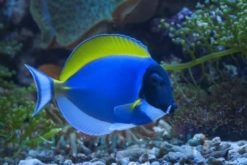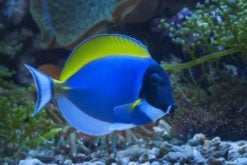Quick Stats for the Powder Blue Tang – South Asia (Acanthurus leucosternon):
- Care Level: Moderate
- Temperament: Semi-aggressive
- Diet: Herbivore
- Reef Safe: No
- Minimum Tank Size: 120 gallons
- Max Size: Up to 9 inches
- Water Parameters: Temperature: 72-78°F, pH: 8.1-8.4, Salinity: 1.020-1.025
Comprehensive Guide to the Powder Blue Tang – South Asia (Acanthurus leucosternon)
The Powder Blue Tang, or Acanthurus leucosternon, is popular in saltwater aquariums. This comprehensive guide will provide all the information about keeping this beautiful fish in your tank.
Habitat
The Powder Blue Tang is native to the waters of South Asia, including the Indian Ocean and the Red Sea. It is commonly found in coral reefs and lagoons, where it feeds on algae and small invertebrates.
Reef Safe
The Powder Blue Tang is considered reef-safe with caution. Some specimens can nip at corals and other sessile invertebrates. If you have a reef tank, it is recommended to be cautious when adding this species.
Size
The Powder Blue Tang can grow up to 9 inches long, making it a relatively large fish for a home aquarium. It is important to provide a spacious tank to accommodate its size.
Temperament
The Powder Blue Tang has a semi-aggressive temperament. It may exhibit territorial behavior and be aggressive towards other fish, especially those of the same species or similar appearance. Introducing this fish to the tank last after other tankmates have established their territories is best.
Sexual Dimorphism
There are no noticeable differences in appearance between male and female Powder Blue Tangs.
Lifespan
The average lifespan of a Powder Blue Tang is around 8 to 10 years, but with proper care and a healthy environment, they can live even longer.
Diet in Aquariums
The Powder Blue Tang is a herbivore and requires a diet rich in algae and other plant matter. It is recommended to provide a variety of foods, including seaweed sheets, frozen herbivore preparations, and live or frozen brine shrimp. Supplementing their diet with vitamin-enriched foods can also help maintain their health.
Aquascaping Recommendations
When setting up the aquarium for a Powder Blue Tang, it is important to provide plenty of swimming space and hiding spots. Rocks and corals can be arranged to create caves and crevices where the fish can retreat when feeling stressed or threatened. It is also beneficial to include live rock with plenty of algae growth to mimic their natural habitat.
Captive Bred Availability
The Powder Blue Tang is not commonly available as captive-bred. Most individuals in the aquarium trade are wild-caught. However, efforts are being made to breed them in captivity to reduce the impact on wild populations.
Compatibility with Other Fish, Invertebrates, or Corals
The Powder Blue Tang can be kept with other peaceful to semi-aggressive fish species that are not similar in appearance. Avoid keeping them with other tangs or surgeonfish, as they may exhibit aggression towards each other. Invertebrates and corals should be chosen carefully, as the Powder Blue Tang may nip at their polyps or tentacles.
Here are five specific tankmates that are good choices for the Powder Blue Tang:
- Purple Tang (Zebrasoma xanthurum) – These two tangs have different coloration and body shapes, reducing the likelihood of aggression.
- Ocellaris Clownfish (Amphiprion ocellaris) – Clownfish are known for their peaceful nature and can coexist with the Powder Blue Tang.
- Firefish Goby (Nemateleotris magnifica) – These small, peaceful fish can add movement to the lower levels of the tank without causing any issues.
- Green Chromis (Chromis viridis) – These schooling fish can create a lively atmosphere in the tank and are compatible with the Powder Blue Tang.
- Cleaner Shrimp (Lysmata amboinensis) – These shrimp can serve as cleaning symbionts for the Powder Blue Tang, helping to keep it free of parasites.
Other Common Names
The Powder Blue Tang is also commonly known as the Powder Blue Surgeonfish or the Powder Blue Tang Surgeonfish.
Why Buy from Reefs4Less.com
Reefs4Less.com is a trusted online retailer specializing in saltwater aquarium supplies. They offer a wide selection of high-quality fish, corals, and other marine life. With their expertise and commitment to customer satisfaction, you can be confident in their products and services.
Popular Questions and Answers for the Powder Blue Tang – South Asia (Acanthurus leucosternon) in Saltwater Aquariums
1. Can the Powder Blue Tang be kept in a reef tank?
The Powder Blue Tang is considered reef-safe. It does well in mature reef colonies with grown out corals.
2. How big of a tank do I need for a Powder Blue Tang?
A minimum tank size of 120 gallons is recommended for a Powder Blue Tang. Providing a larger tank will give the fish more space to swim and explore.
3. What should I feed my Powder Blue Tang?
The Powder Blue Tang is a herbivore and requires a diet rich in algae and other plant matter. Offer a variety of foods, including seaweed sheets, frozen herbivore preparations, and live or frozen brine shrimp.
4. Can the Powder Blue Tang be kept with other tangs?
Keeping the Powder Blue Tang with other tangs or surgeonfish is generally not recommended, as they may exhibit aggression towards each other.
5. How long do Powder Blue Tangs typically live?
The average lifespan of a Powder Blue Tang is around 8 to 10 years, but with proper care and a healthy environment, they can live even longer.





Reviews
There are no reviews yet.